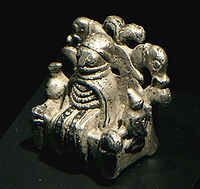- Odin from Lejre
-
Odin from Lejre is a small cast silver figurine from approximately 900 C.E., showing a person sitting on a throne. The figurine has inlay of black niello (black coloured alloy) and some gilding.[1][2] The height is 18 mm and the weight is 9 grams.[3] The figurine was found by local amateur archaeologist Tommy Olesen on September 2, 2009, during Roskilde Museum's excavations at the small village of Gammel Lejre (Old Lejre), near the modern town of Lejre.[1] in Denmark. The figurine was unveiled at the Roskilde Museum on November 13, 2009, and is now part of the permanent exhibition.
The person on the throne wears a floor-length dress, an apron, four bead necklaces, a neck ring, a cloak and a rim-less hat. Two birds are seated on the armrests and the back of the throne shows the heads of two animals.
It has been a matter of dispute whom the person on the throne is intended to depict. The excavator interpreted it as Odin, the chief god in Norse paganism and the ruler of Asgard, sitting on his throne Hlidskjalf, from which he sees into all the worlds. The birds would be the ravens Hugin and Munin, who gathered information for Odin. The beast-heads might symbolise Odin's two wolves, Geri and Freki. Historically, Lejre was reported to be the site of sacrifices to Odin held every ninth year during the Viking Age.[4]
Scholars specialising in Viking Period dress and gender representations, however, have pointed out that the person is dressed entirely in female attire, making it more probably a goddess such as Freya or Frigga[5]
References
- ^ a b Louise Lauritsen, "Et unikt fund af Odin fra Lejre", Roskilde Avis, November 13, 2009 (Danish)
- ^ "Odin fra Lejre" on Roskilde Museum website (Danish).
- ^ further information page on Roskilde Museum website (Danish).
- ^ Otte, Elise C. (1894). Scandinavian History. MacMillan & Co. pp. 37–38. http://books.google.com/books?id=Wn4-AAAAYAAJ&printsec=frontcover&source=gbs_v2_summary_r&cad=0#v=onepage&q&f=false.; Davidson, Hilda Roderick Ellis (1988). Myths and Symbols in Pagan Europe: Early Scandinavian and Celtic Religions. Manchester University Press. pp. 58–60. ISBN 7190-2207-X. http://books.google.com/books?id=RerIAAAAIAAJ&printsec=frontcover&source=gbs_v2_summary_r&cad=0#v=onepage&q&f=false.
- ^ Óluva Ellingsgaard, "Var Odin en kvinde?", Videnskab.dk, January 27, 2010 (Danish)
External links
- Odin from Lejre - a unique find at Roskilde Museum - Official release from the Roskilde Museum website (in English)
Categories:
Wikimedia Foundation. 2010.

